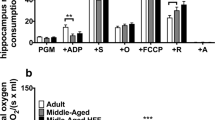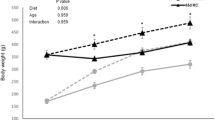We examined the effects of supplementation of old rats with vitamin E (alpha-tocopherol, αTPh, acetate) on phospholopid (PL) metabolism in the brain and cognitive functions of these animals. Intragastric administration of αTPh to 24-month-old rats for 14 days resulted in a noticeable increase in the level of newly synthesized phosphatidylserine (PS) in the hippocampus of experimental animals, as compared with control rats. At the same time, there was a decrease in the [14C] phosphatidylcholine (PC) content in the hippocampus of experimental rats vs. controls. Changes in the PL levels observed in the hippocampus of experimental animals due to αTPh administration were associated with an increased number of active avoidances and a decreased latent period of these events within acquisition of the respective conditioned reflex in a shuttle box. The data obtained provide evidence that αTPh is a potent modulator of PL metabolism in the hippocampus and functions of the latter at old age.
Similar content being viewed by others
References
R. Mozzi, S. Buratta, and G. Goracci, “Metabolism and functions of phosphatidylserine in mammalian brain,” Neurochem. Res., 28, No. 2, 195-214 (2003).
F. Casamenti, C. Scali, and G. Pepeu, “Phosphatidylserine reverses the age-dependent decrease in cortical acetylcholine release: a microdialysis study,” Eur. J. Pharmacol., 194, No. 1, 194-211 (1991).
M. A. McDaniel, S. F. Maier, and G. O. Einstein, “‘Brain-specific’ nutrients: a memory cure?” Nutrition, 19, Nos. 11–12, 957-975 (2003).
M. L. Bader-Lange, G. Cenini, M. Piroddi, et al., “Loss of phospholipid asymmetry and elevated brain apoptotic protein levels in subjects with amnestic mild cognitive impairment and Alzheimer disease,” Neurobiol. Dis., 29, No. 3, 456-464 (2008).
N. A. Babenko and Ya. A. Semenova, “Effects of long-term fish oil-enriched diet on the sphingolipid metabolism in brain of old rats,” Exp. Gerontol., 45, No. 5, 375-380 (2010).
M. G. Nunzi, F. Milan, D. Guidolin, and G. Toffano, “Dendritic spine loss in hippocampus of aged rats. Effect of brain phosphatidylserine administration,” Neurobiol. Aging, 8, No. 6, 501-510 (1987).
N. A. Babenko and Ya. A. Semenova, “Effects of exogenous phosphatidylserine on cognitive functions and phospholipid metabolism in the hippocampus of aged rats,” Neurosci. Behav. Physiol., 41, No. 1, 97-101 (2011).
M. Akbar, F. Calderon, Z. Wen, and H.-Y. Kim, “Docosahexaenoic acid: a positive modulator of Akt signaling in neuronal survival,” Proc. Natl. Acad. Sci. USA, 102, 10858-10863 (2005).
V. Chandra, J. Jasti, P. Kaur, et al., “First structural evidence of a specific inhibition of phospholipase A2 by alpha-tocopherol (vitamin E) and its implications in inflammation: crystal structure of the complex formed between phospholipase A2 and alpha-tocopherol at 1.8 A resolution,” J. Mol. Biol., 320, No. 2, 215-222 (2002).
T. Abe, X. Lu, Y. Jiang, et al., “Site-directed mutagenesis of the active site of diacylglycerol kinase alpha: calcium and phosphatidylserine stimulate enzyme activity via distinct mechanisms,” Biochem. J., 375, Pt. 3, 673-680 (2003).
N. A. Babenko, L. Kh. Hassouneh, V. S. Kharchenko, and V. V. Garkavenko, “Vitamin E prevents the agedependent and palmitate-induced disturbances of sphingolipid turnover in liver cells,” Age (Dordr.), 34, No. 4, 905-915 (2012).
N. A. Babenko and E. G. Shakhova, “Long-term food restriction prevents aging-associated sphingolipid turnover dysregulation in the brain,” Arch. Gerontol. Geriatr., 58, No. 3, 420-426 (2014).
S. Grether-Beck, A. Timmer, I. Felsner, et al., “Ultraviolet A-induced signaling involves a ceramidemediated autocrine loop leading to ceramide de novo synthesis,” J. Invest. Dermatol., 125, No. 3, 545-553 (2005).
C. Mazière, M. A. Conte, L. Leborgne, et al., “UVA radiation stimulates ceramide production: relationship to oxidative stress and potential role in ERK, JNK, and p38 activation,” Biochem. Biophys. Res. Commun., 281, No. 2, 289-294 (2001).
K. Ayasolla, M. Khan, A. K. Singh, and I. Singh, “Inflammatory mediator and beta-amyloid (25-35)-induced ceramide generation and iNOS expression are inhibited by vitamin E,” Free Radical Biol. Med., 37, No. 3, 325-338 (2004).
K. Yamagata, S. Ichinose, C. Tagawa, and M. Tagami, “Vitamin E regulates SMase activity, GSH levels, and inhibits neuronal death in stroke-prone spontaneously hypertensive rats during hypoxia and reoxygenation,” J. Exp. Stroke Transl. Med., 2, No. 2, 41-48 (2009).
S. G. Meyer and H. de Groot, “[14C]serine from phosphatidylserine labels ceramide and sphingomyelin in L929 cells: evidence for a new metabolic relationship between glycerophospholipids and sphingolipids,” Arch. Biochem. Biophys., 410, No. 1, 107-111 (2003).
G. Pepeu, I. M. Pepeu, and L. Amaducci, “A review of phosphatidylserine pharmacological and clinical effects. Is phosphatidylserine a drug for the ageing brain,” Pharmacol. Res., 33, No. 2, 73-80 (1996).
E. G. Bligh and W. J. Dyer, “A rapid method of total lipid extraction and purification,” Can. J. Biochem. Physiol., 37, No. 8, 911-917 (1959).
G. R. Bartlett, “Phosphorus assay in column chromatography,” J. Biol. Chem., 234, No. 3, 466-468 (1959).
J. E. Vance, “Phosphatidylserine and phosphatidylethanolamine in mammalian cells: two metabolicallyrelated aminophospholipids,” J. Lipid Res., 49, No. 7, 1377-1387 (2008).
M. Wong and J. K. Lodge, “A metabolomic investigation of the effects of vitamin E supplementation in humans,” Nutr. Metab. (Lond.), 9, No. 1, 110 (2012).
J. P. Woronczak, H. Poddana, E. Siucińska, et al., “Metabolic conversion of phosphatidylserine via phosphatidylethanolamine into phosphatidylcholine in rat brain,” Biochem. Mol. Biol. Int., 30, No. 6, 1153-1160 (1993).
G. A. Salvador, F. M. López, and N. M. Giusto, “Agerelated changes in central nervous system phosphatidylserine decarboxylase activity,” J. Neurosci. Res., 70, No. 3, 283-289 (2002).
V. B. Junqueira, B. M. Barros, S. S. Chan, et al., “Aging and oxidative stress,” Mol. Aspects Med., 25, Nos. 1–2, 5-16 (2004).
I. Rodrigues Siqueira, C. Fochesatto, I. L. da Silva Torres, et al., “Aging affects oxidative state in hippocampus, hypothalamus and adrenal glands of Wistar rats,” Life Sci., 78, No. 3, 271-278 (2005.
A. Navarro, M. J. Bandez, J. M. Lopez-Cepero, et al., “High doses of vitamin E improve mitochondrial dysfunction in rat hippocampus and frontal cortex upon aging,” Am. J. Physiol. Regul. Integr. Comp. Physiol., 300, No. 4, R827-R834 (2011).
B. F. Serinkan, Y. Y. Tyurina, H. Babu, et al., “Vitamin E inhibits anti-Fas-induced phosphatidylserine oxidation but does not affect its externalization during apoptosis in Jurkat T cells and their phagocytosis by J774A.1 macrophages,” Antioxid. Redox Signal., 6, No. 2, 227-236 (2004).
K. H. Choy, O. Dean, M. Berk, et al., “Effects of N-acetyl-cysteine treatment on glutathione depletion and short-term spatial memory deficit in 2-cyclohexen- 1-one-treated rats,” Eur. J. Pharmacol., 649, Nos. 1–3, 224-228 (2010).
J. M. Robillard, G. R. Gordon, H. B. Choi, et al., “Glutathione restores the mechanism of synaptic plasticity in aged mice to that of the adult,” PLoS One, 6, No. 5, e20676 (2011).
A. L. Fu, Z. H. Dong, and M. J. Sun, “Protective effect of N-acetyl-L-cysteine of amyloid β-peptide-induced learning and memory deficits in mice,” Brain Res., 1109, No. 1, 201-206 (2006).
J. A. Araujo, G. M. Landsberg, N. W. Milgram, and A. Miolo, “Improvement of short-term memory performance in aged beagles by a nutraceutical supplement containing phosphatidylserine, Ginkgo biloba, vitamin E, and pyridoxine,” Can. Vet. J., 49, No. 4, 379-385 (2008).
L. Puglielli, R. E. Tanzi, and D. M. Kovacs, “Alzheimer’s disease: the cholesterol connection,” Nat. Neurosci., 6, No. 4, 345-351 (2003).
R. G. Cutler, J. Kelly, K. Storie, et al., “Involvement of oxidative stress-induced abnormalities in ceramide and cholesterol metabolism in brain aging and Alzheimer’s disease,” Proc. Natl. Acad. Sci. USA, 101, No. 7, 2070-2075 (2004).
C. Costantini, R. Weindruch, G. Della Valle, and L. Puglielli, “A TrkA-to-p75NTR molecular switch activates amyloid β-peptide generation during aging,” Biochem. J., 391, Pt. 1, 59-67 (2005).
L. Puglielli, B. C. Ellis, A. J. Saunders, and D. M. Kovacs, “Ceramide stabilizes beta-site amyloid precursor protein-cleaving enzyme 1 and promotes amyloid beta-peptide biogenesis,” J. Biol. Chem., 278, No. 22, 19777-19783 (2003).
N. A. Crivello, I. H. Rosenberg, G. E. Dallal, et al., “Age-related changes in neutral sphingomyelin-specific phospholipase C activity in striatum, hippocampus, and frontal cortex: implication for sensitivity to stress and inflammation,” Neurochem. Int., 47, No. 8, 573-579 (2005).
V. Mansat, G. Laurent, T. Levade, et al., “The protein kinase C activators phorbol esters and phosphatidylserine inhibit neutral sphingomyelinase activation, ceramide generation, and apoptosis triggered by daunorubicin,” Cancer Res., 57, No. 23, 5300-5304 (2005).
Author information
Authors and Affiliations
Corresponding author
Rights and permissions
About this article
Cite this article
Hassouneh, L.K.M. Effects of Vitamin E on the Synthesis of Phospholipids and Brain Functions in Old Rats. Neurophysiology 50, 166–172 (2018). https://doi.org/10.1007/s11062-018-9733-3
Received:
Published:
Issue Date:
DOI: https://doi.org/10.1007/s11062-018-9733-3




